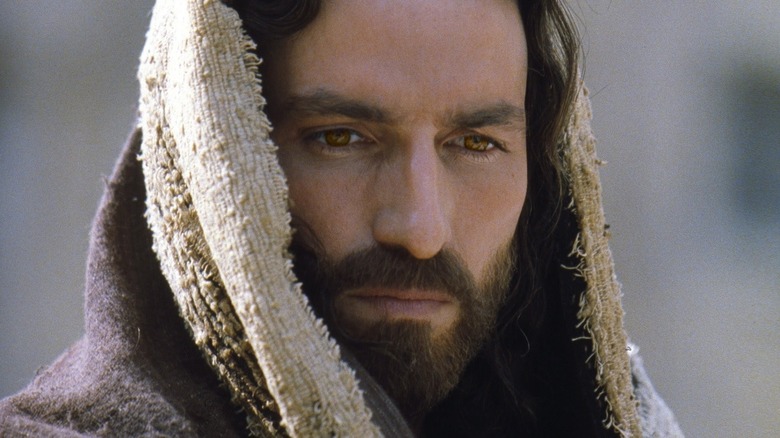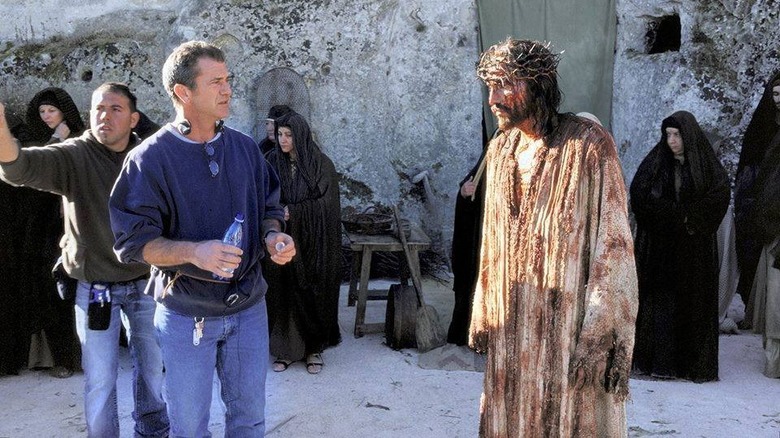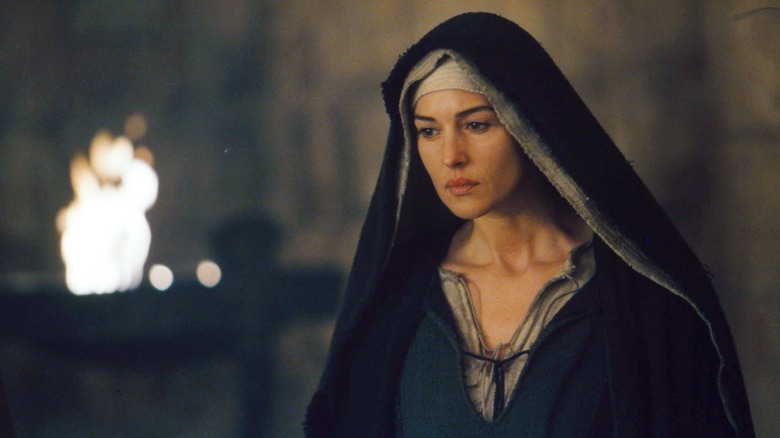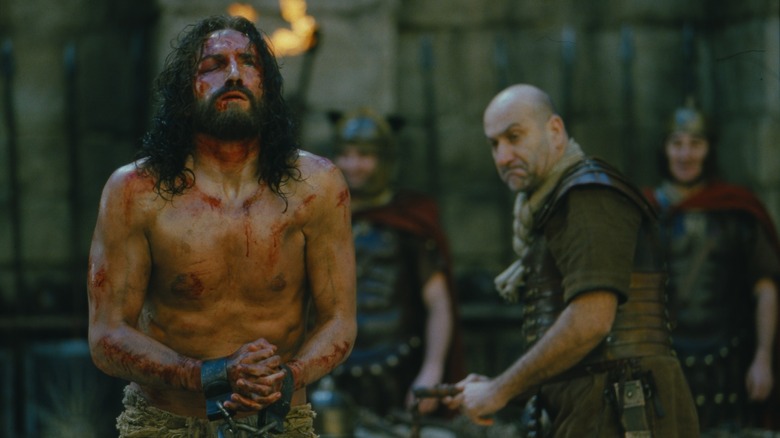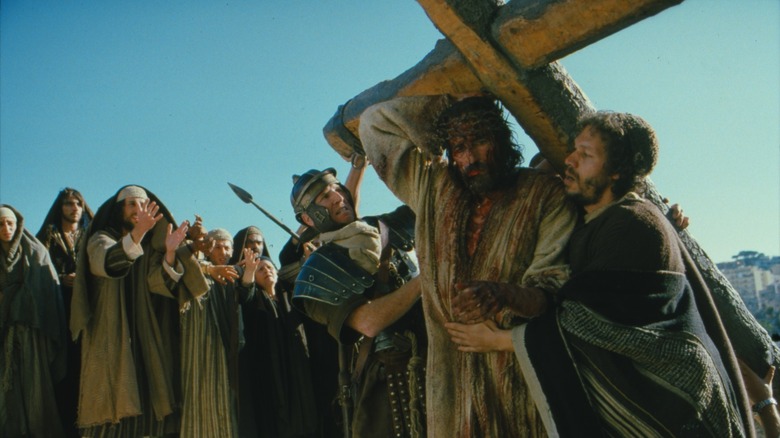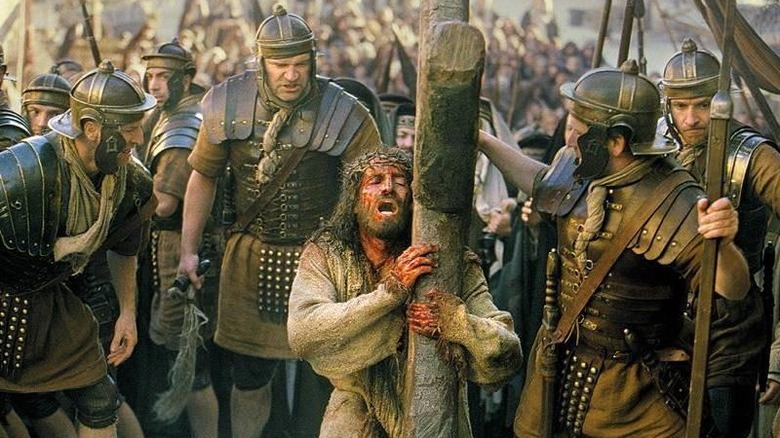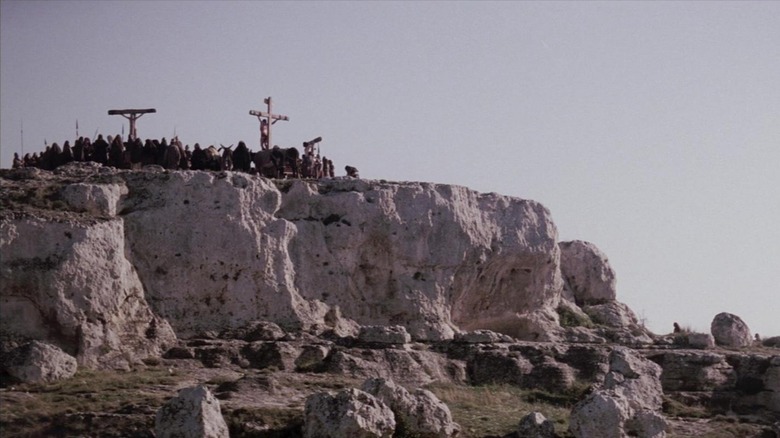20 Years Ago, The Passion Of The Christ Turned Faith-Based Bloodshed Into Box Office Glory
(Welcome to Tales from the Box Office, our column that examines box office miracles, disasters, and everything in between, as well as what we can learn from them.)
As we've seen in recent years, horror remains a recipe for success at the box office. Truthfully, it's been that way for decades. Another trend that has emerged in the aftermath of the pandemic is faith-based cinema breaking out in theaters, with the controversial "Sound of Freedom" leading the way. To that end, controversy can sometimes fuel massive ticket sales. 20 years ago, one movie combined every single one of those elements to deliver the biggest R-rated movie of all time. That movie was "The Passion of the Christ."
Directed by Mel Gibson, the film focuses on the last 12 hours of in the life of Jesus of Nazareth, played by James Caviezel. The film begins with Jesus praying after the Last Supper before being betrayed by Judas Iscariot. He is then arrested and taken within the city walls of Jerusalem where leaders of the Pharisees confront him with accusations of blasphemy, resulting in condemning him to death.
"Critics who have a problem with me don't really have a problem with me in this film. They have a problem with the four Gospels. That's where their problem is," Gibson said in his interview with Diane Sawyer in 2006 addressing the controversies that erupted over the film's violence and offensive depiction of Jewish people. Whatever problems critics had with the filmmaker or his film, it hardly mattered in the end.
In this week's Tales from the Box Office, in honor of the film's 20th anniversary, we're looking back at Gibson's controversial religious epic. We'll look back at how it came to be, how the film struggled to find a studio to distribute it, what happened when it finally hit theaters, and what lessons we can learn from it all these years later. Let's dig in, shall we?
The movie: The Passion of the Christ
Mel Gibson rose through the Hollywood ranks in the '80s and '90s as an actor starring in hits such as "The Road Warrior" and "Lethal Weapon." Gibson's major turning point was when he stepped behind the camera, with his 1995 directorial effort "Braveheart" becoming a huge Best Picture-winning hit, historically inaccurate though it may be. That placed Gibson atop of the A-list, though he was selective about the films he chose to direct.
He opted to focus on another important figure from history; Jesus Christ. In a 2003 interview with Zenit, Gibson explained how this came to be the story he wanted to tell.
"I had always believed in God, that he existed, and I was brought up to believe in a certain way. But in my middle years, I kind of drifted, and other things took center stage. At that point, I realized I needed something more if I was going to survive. A closer investigation of the Gospels, of the story, of the whole piece, was demanded of me. That's when the idea started to percolate inside my head. I began to see it realistically, re-creating it in my own mind so that it would make sense for me, so I could relate to it. That's what I want to put on the screen."
What sets Gibson's film apart to this very day is the depiction of graphic violence. He did not shy away from the gory details when it came to crucifying Jesus, and that would become a major talking point. In that same 2003 interview, Gibson addressed it head-on and made his feelings clear.
"There is no gratuitous violence in this film. I don't think anyone under 12 should go see it — unless they're a very mature 12-year-old. It's pretty heavy. I think we have gotten too used to seeing pretty crucifixes on the wall and we forget what really happened. I mean, we know that Jesus was scourged, that he carried his cross, that he had nails put through his hands and feet, but we rarely think about what this means."
The Passion had trouble finding a distributor
By the time Gibson began developing the film, which he wrote alongside Benedict Fitzgerald, he had made a fortune from his previous exploits in the business. He, in turn, invested that money through his company Icon Productions to put up the budget for "The Passion of the Christ," which amounted to about $30 million. This was made outside the studio system and, ultimately, would be distributed independently as well.
Well before the movie hit theaters, whispers began cropping up that the film was incredibly violent, in addition to sparking controversy for its depiction of Jewish people. That's a big part of the reason why 20th Century Fox and other distributors passed on releasing the movie, per a 2003 report from the Los Angeles Times. Jewish leaders were accusing the film of being antisemitic, with clips of the film that had made their way out into the world showing Jewish people celebrating as a tortured Jesus carried the cross.
"Icon told us that it has a number of alternative distribution options that it is pursuing. In light of this, Fox and Icon agreed late last week that Fox will not be involved in the release of the film," Fox said in a statement at the time. In the end, Gibson and Icon decided to go the independent route, enlisting Newmarket Films ("Whale Rider," "Memento") to assist in shipping prints of the film and collecting money from theaters.
Christ finds a loyal following
It's true that Hollywood studios weren't willing to touch "The Passion" with a 40-foot pole, and the movie was getting a lot of negative press ahead of its release. But that all kind of helped to build a great deal of awareness, and it's the kind of awareness that no major marketing campaign can buy. To that end, Gibson and his partners opted to forgo a traditional marketing rollout, with no formal press junkets or pricey trailer buys. Instead, they leaned on church leaders and religious institutions to help spread the word, which they were happy to do.
"A lot of church leaders went out and told their congregations to see the film — they actually booked tickets themselves," The Hollywood Reporter's Greg Kilday said to NBC News in 2004. "Some theaters have sold out their opening days to church affiliated groups, so we really haven't seen this kind of grass roots campaign take off like this before."
Christian media agency faithHighway partnered with Gibson and Icon as well. They made promos for individual churches using footage from the film. Then-faithHighway President Shane Harwell had this to say about it at the time:
"We have had over 400 pastors that have come aboard on this opportunity in less than four weeks, and if you look at that type of count, that is about six times our normal traffic in terms of people wanting to get involved with using the media to reach out, so it's been tremendous."
The financial journey
Gibson and Co. opted to release "The Passion of the Christ" on Wednesday, February 25, 2004. This just so happened to be Ash Wednesday, which marks the beginning of Lent. It was a major religious movie at an important time for religious people. The timing couldn't have been better. It shot out of the gate like a cannon, delivering a monster opening day of $26.5 million. That would prove to be just the very tip of the iceberg for this R-rated lightning rod for controversy that was, simultaneously, embraced by its target audience far and wide.
"The Passion" topped its opening weekend with a massive $83.8 million haul. The next closest on the charts that weekend? "50 First Dates" with $12.5 million. Overall, it pulled in $125 million through its first five days, which essentially tied for the biggest Wednesday opening ever up to that point, matching "The Lord of the Rings: The Return of the King," which had opened just a few months earlier. Gibson's film stayed at number one for three weekends, fending off newcomers such as "Starsky & Hutch" and "Secret Window." It surrendered the crown to, of all things, Zack Snyder's "Dawn of the Dead" remake in mid-March. By that point, it was already a ridiculously huge hit and its placement on the charts hardly mattered.
The film finished its run with $370.2 million domestically to go with $241.2 million internationally for a grand total of $611.4 million worldwide in its original run. It to this day ranks as the highest-grossing R-rated movie ever at the domestic box office, and the highest-grossing independent movie ever produced. It was also the fifth biggest movie of 2004 overall globally behind "The Incredibles" ($631 million), "Spider-Man 2" ($788 million), "Harry Potter and the Prisoner of Azkaban" ($795 million), and "Shrek 2" ($928 million).
Controversy couldn't keep Christ down
Critics were very mixed on the film in its day. "The Passion" currently holds a 49% approval rating on Rotten Tomatoes, for what it's worth. For seemingly every critic that praised Gibson's religious epic as being an immersive experience, others were there to call it a "snuff film." The famed critic Roger Ebert famously called it "the most violent film I have ever seen." That's saying something.
Be that as it may, so many viewers under the age of 17 were allowed to go with church groups or with families because there was an importance placed upon the story, and the violence was somehow viewed as acceptable given that it was being used to tell the story of Jesus. For his part, Gibson explained in that same Diane Sawyer interview that he intended for it to be extreme.
"I wanted it to be shocking; and I wanted it to be extreme ... So that they see the enormity of that sacrifice; to see that someone could endure that and still come back with love and forgiveness, even through extreme pain and suffering and ridicule. The actual crucifixion was more violent than what was shown on the film, but I thought no one would get anything out of it."
Gibson would later court controversy of his own after domestic violence charges were brought against him along with some now-infamous antisemitic rants that essentially excised him from Hollywood for years. "South Park" was even ahead of the curve on that one. At one point, Robert Downey Jr. tried to go to bat for him to get him to direct "Iron Man 4" and lobbied for the business to give him another chance. The accusations of antisemitism in this film certainly took on new meaning following Gibson's outbursts, and it is very difficult to look at this piece of work in the same light some two decades later.
The lessons contained within
I could talk a lot about Gibson as a filmmaker here. I could make some commentary on separating the man from the filmmaker, or weigh in on the ability to separate art from the artist. That all feels bigger than the movie at hand — and this was a massive movie. Instead, I'd like to marvel at what Gibson and his fellow filmmakers were able to pull off here. They, in essence, used a Jesus movie as a Trojan Horse to deliver a shockingly violent picture, allowing a gory, ultra-bloody horror show to find record-breaking box office glory. That was impressive then and it remains impressive now.
Have shocking horror movies made lots of money in the past? You bet! Just look at "The Exorcist" or even the surprise success of "Terrifier 2." But we're either talking about movies that weren't nearly as violent or made a fraction of the money. This was mainstream success on par with some of the biggest movies in the history of cinema. Yet, calling it like it is, it was also an R-rated gore show using a religious tale as inspiration. That, in turn, opened it up to a much wider audience than virtually any other movie this violent would have been capable of finding.
That's certainly why Gibson is still toying with the idea of making a sequel to "The Passion" about the resurrection. Again, Gibson's transgressions paint that in an immediately different light. But rest assured, no matter how many people shout that Gibson should not be granted a mass audience after what he's said and what he's done off-screen, the audience for such a movie is undoubtedly out there. The moviegoing masses chose to overlook over-the-top violence and antisemitism in 2004, and they probably would overlook it again.
